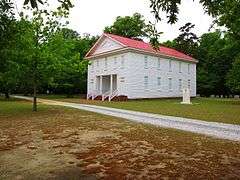Old Bluff Presbyterian Church
|
Old Bluff Presbyterian Church | |
 | |
  | |
| Location | North of Wade on SR 1709, near Wade, North Carolina |
|---|---|
| Coordinates | 35°11′2″N 78°43′25″W / 35.18389°N 78.72361°WCoordinates: 35°11′2″N 78°43′25″W / 35.18389°N 78.72361°W |
| Area | 9.5 acres (3.8 ha) |
| Built | 1855 |
| Architectural style | Greek Revival |
| NRHP Reference # | 74001345[1] |
| Added to NRHP | August 7, 1974 |
Old Bluff Presbyterian Church is a historic Presbyterian church located near Wade, Cumberland County, North Carolina.
The church congregation was founded in 1758. Later its pastor was the Rev. John McLeod, who came from the Isle of Skye, Scotland, in 1770. He was accompanied by many families of Highland Scots.[2] In 1858 the congregation dedicated a new church building constructed in the Greek Revival style.[3]
The church is a plain, weatherboarded building with details that appear to be neoclassical moldings, including drill work suggesting triglyphs, dentils, and egg-and-dart, on the frieze and pediment.[4] It is a large Greek Revival style temple form building. It features a one-story, three-bay tetrastyle porch in antis.[5]
It was listed on the National Register of Historic Places in 1974.[1] it is also thought to be haunted by one of the priest who was shot and killed in the church
References
- 1 2 National Park Service (2010-07-09). "National Register Information System". National Register of Historic Places. National Park Service.
- ↑ Bigelow, Francis Hill (1917). Historic Silver of the Colonies and Its Makers, p. 48. The Macmillan Company.
- ↑ Conser, Walter H. (2006). A Coat of Many Colors: Religion and Society Along the Cape Fear River of North Carolina, p. 116. The University Press of Kentucky.
- ↑ Bishir, Catherine W. (portable ed. 2005). North Carolina Architecture, pp. 226-27. The Historic Preservation Foundation of North Carolina, Inc.
- ↑ Survey and Planning Unit Staff (March 1974). "Old Bluff Presbyterian Church" (pdf). National Register of Historic Places - Nomination and Inventory. North Carolina State Historic Preservation Office. Retrieved 2014-08-01.

